More information about this website & why it was created can be found by visiting this website's "front" pages (link opens in a new window)
A series of pages which look at different types of passenger trains
as defined by the type of service they are designed to provide.
Long Distance InterCity Trains looks at trains which are designed for InterCity express journeys with journey times usually in excess of 45 minutes and possibly lasting for many hours. This includes super-fast very high speed trains and tilting trains.
Medium Distance Trains looks at different types of trains that provide medium distance services, typically with journey times of between 30 and 90 minutes in duration, but sometimes longer too.
Short Distance Trains looks at trains designed for journeys of anything from less than a minute up to about 45 minutes within urban areas and their close hinterland. These trains could be operated by either a mainline railway company or a city-specific regional transport authority. Included within this remit are Automated 'Driverless' Metro Systems and Trams, Streetcars and Light Rail Vehicles; however to avoid making a very large page the latter two topics have their own dedicated pages.
"Walk-through" Trains looks at the need to be able to walk from carriage to carriage along an entire train's length, this being an aspect of train design where practical day-to-day passenger requirements are often compromised.
On-train Refreshment Facilities, Double-Deck Trains, & Taking Bicycles On Trains looks at three specific aspects of railway operation which transcends all the other categories as described above.
These trains would normally be designed for short journeys of anything from less than a minute (ie: the next station) up to about 45 minutes within urban areas and their close hinterland.
With these trains high capacity will usually be the criteria rather than high comfort, with the train's insides being designed along the theme of cramming in as many people as possible.
If there is also a desire to maximise seating capacity then this will usually mean the 3+2 high density format of seating, where there are 3 seats on one side and 2 on the other side of a central gangway which typically extends along the length of the carriage. On trains which are wide enough then the seating may even be in 3+3 format.
Alternatively some train operators use 2+2 seating (or even longitudinal seating) because it makes extra space for standing passengers. Indeed, especially in the rush hours there will not always be enough seating for every passenger so some people travelling on services provided by these trains will expect to have to stand for all or part of their journey.
A few train operators even include carriages which do not provide any seating at all. Primarily this is in Asia, and only part of the train has such carriages.
As with all rail services these trains will vary in length according to city size, expected passenger flows etc with longer trains for the busiest routes in bigger cities and shorter trains for quieter routes or smaller cities. Where the infrastructure permits (tunnels are large enough, over-bridges not too low, etc) some cities use double-deck trains as these can carry far more passengers in a given train length and reduce the need for longer trains (and longer platforms which can be expensive to construct). Very few lines in Britain are suitable for double-deck trains and those which are suitable are generally not the busiest so do not need them. Unfortunately the lines which suffer the most severe overcrowding (mostly commuter routes into south London) are not suitable for them.
To allow for passengers to exit from / enter the entire train double deck trains often require longer station dwell times than single deck trains. When compared to trains formed of solely single deck rolling stock this can reduce overall train throughput, which means that there will be fewer trains per hour on that section of track. This may not matter however if there are other constraints on train frequency, such as the overall size of the fleet of trains or that the signalling system restricts how many trains can pass through the area in a given amount of time.
Typically short distance trains are not equipped with toilets, buffets or other 'niceties' found on longer distance trains - however there are exceptions to this rule.
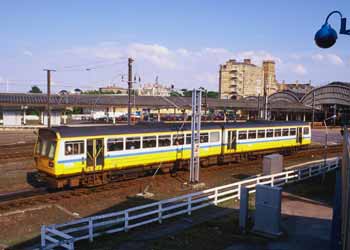 |
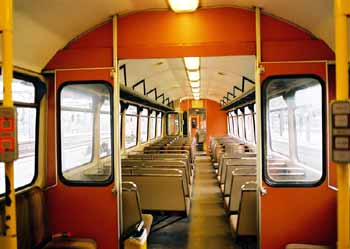 |
||||
| Known as Pacers (or Skippers on the Western Region) these are the most basic trains. They were designed as 'no frills' railbuses to provide a very basic low-cost service on
short distance rural and commuter routes where the transport is socially necessary but might not be financially viable - although some railcos use them on longer journeys too.
In some regions these trains have been refurbished internally and fitted with more luxurious seating, perhaps with the longitudinal seating (such as in the area nearest to the doors) being removed as it makes space for luggage, pushchairs, bicycles, etc. |
|||||
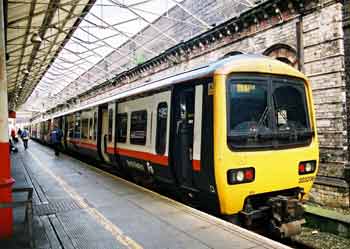 |
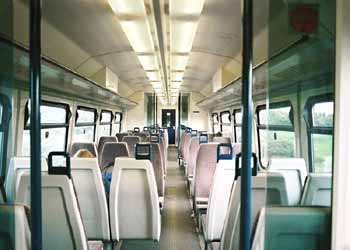 |
||||
| These 'inner-suburban' trains operate in the Birmingham and Manchester areas. Manchester version shown. |
|||||
 |
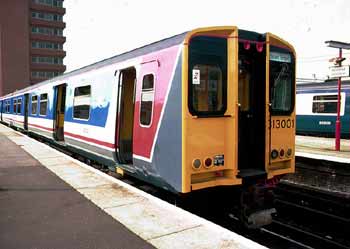 |
||||
'Inner-suburban' trains similar to this operate on services in the Glasgow, Liverpool, London, Hertfordshire and south coast areas.
Illustrated here are examples from Glasgow (Strathclyde PTE) left and London (Network SouthEast) right (also seen in the background is part of a train in the original nationwide BR standard blue/grey livery). (Liverpudlian examples are seen in the section which looks at underground railways below). All the trains shown in the three pairs of pictures above were designed by the former British Railways and except perhaps for the liveries (paint / colour) when introduced into service were more or less identical nationwide (within the type of train). However, since railway privatisation the various train operating companies have repainted their variants in a range of different liveries and in some cases have also refurbished them so that they look different and / or feature different types of seating. Nowadays virtually all British trains* feature power operated doors that are controlled by either a guard or driver. Even if the trains also feature passenger operated 'open' and 'close' buttons the train driver or guard will still (usually) have the ultimate control. *(except historic trains on museum railways).A specific problem often faced by trains with power operated doors is that rather than spread out evenly throughout the carriage many passengers congregate in the doorway, which at stations blocks access to the rest of the carriage and extends the time it takes passengers to board and alight (ie; the 'dwell' time). A solution which has been adopted on some trains is to redesign the entrance area inside the train to create a larger circulating space just inside the doorway. Sometimes this involves removing seats and making a space that is setback from the doors, other times it sees transverse seats replaced with longitudinal seating - which also makes more space for standing passengers. |
|||||
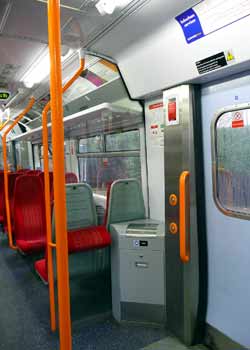 |
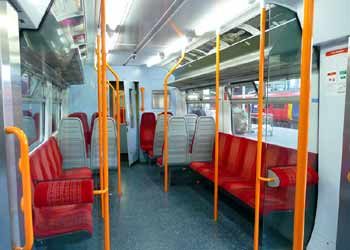 |
||||
| Various solutions designed to discourage passengers from standing just inside the doorways and effectively blocking access to the rest of the carriage. Note the 'bum rests' in the set-back area. |
|||||
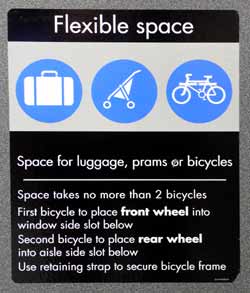 |
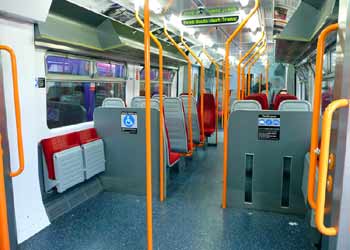 |
||||
| Sometimes the set-back area can also be used as a 'flexible space' for passengers with special requirements, such as personal wheeled transport or carrying heavy luggage. |
|||||
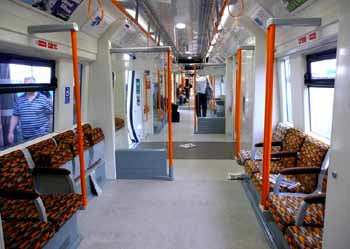 |
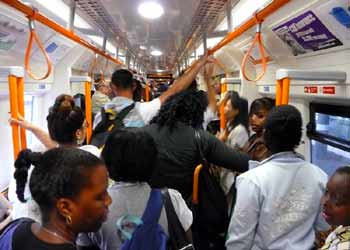 |
||||
| In 2009 some fully airconditioned trains were introduced in London with a fully 'walk-through' design and solely longitudinal seating; this seating layout was chosen because it creates more space for standing passengers. The image on the left was taken immediately after everyone had left the train at its end of line - which explains why it was possible to source a view of an almost empty train. Note the fixed arm rests which dictate how much seating space passengers may take (and prevent people from laying down), the draught-screens, the folding seats which create a shared space for 'personal wheeled transports' and the otherwise ordinary seat (opposite) which is in a different colour moquette to identify it as being a priority seat. Plus the discarded free newspapers which some passengers often like to read. The image on the right shows a typical 'shoulder of rush hour' view - at the busiest times the trains become even more crowded. Indeed, at one specific station the rush hour crowds are such that two Japanese-style platform staff 'packers' are required to 'help' everyone squeeze aboard. Some of the routes served by these trains were first electrified in the 1920's, using trains which at the time were noted for being the most comfortable urban trains in London. Many passengers would suggest that these new trains represent the opposite end of the transport spectrum and ponder whether there is a connection with the new trains having fewer carriages (just 4) than some of the services did when using the 1920's trains (3 at quiet times and 6 at busy times). |
|||||
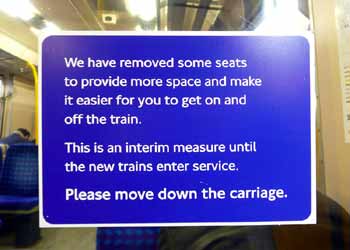 |
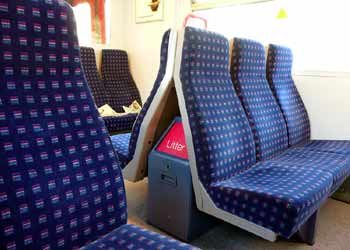 |
||||
| Prior to the introduction of the new trains as described above a solution which had been adopted to create more standing space within the train as well as make space for 'personal wheeled transports' was the removal of some seats, including reducing the seating layout from high density 3+2 to 2+2. This sign explains it all. | Some trains locate litter bins between the seats, as seen here. However, as seen on the next seating bay this does not stop passengers from discarding used newspapers by leaving them laying around / on the seats. | ||||
 |
 |
||||
| The Dublin Area Rapid Transit (DART) provides a suburban service linking coastal communities to the north and south of the city via a route which skirts just to the east of the cities' central business district. These are the only electric trains in Ireland, although there are other regional and Inter-City services which for the most part operate over the same tracks. | Some DART trains feature these LED route describers - green indicates the route which has already been travelled, orange the route expected to be followed, solid red the train's destination station and flashing red the next station. Clicking the image will display a larger version in a new window. | ||||
In Australia urban rail services (where they exist) are operated regionally, based on the various State Capitals - Perth, Western Australia (WA); Melbourne, Victoria (Vic); Brisbane, Queensland (Qld); Sydney, New South Wales (NSW) which have electric urban systems and Adelaide, South Australia (SA) which for many only had diesel trains but by 2013 was converting some routes to electric traction. Melbourne, Adelaide and Sydney also have electric tram systems. Queensland and New South Wales also have electrified regional / InterCity services, and especially in Sydney there is much overlap where some services which act as urban / suburban trains within the city then continue their journeys to serve nearby regional towns. No Australian cities have true "urban transit" underground railway systems however in Sydney, Melbourne and Perth city centres some of their services have been located below ground where they operate as underground railways. In many ways this is a very similar arrangement to that which exists in the English city of Liverpool. |
|||||
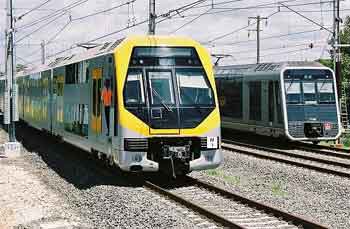 |
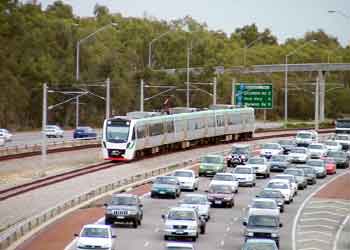 |
||||
| Nowadays most trains in New South Wales (NSW) are double deckers, these CityRail trains are known as "Millennium" left and "Tangara" right.
Image: David Johnson http://members.ozemail.com.au/%7Etrainman/main.html (Link deactivated as it no longer works) |
Apart from NSW all other Australian rail services use single deck trains. The example seen here comes from the TransPerth
system which serves Perth and its close hinterland, it shows a B series train speeding past morning traffic jams on the Mitchell Freeway as it heads to Perth on the Joondalup Line.
Image & license: V1213 / Wikipedia encyclopædia. CC BY-SA 3.0 http://commons.wikimedia.org/wiki/File: Mitchell_Freeway_100_N_Stirling_Civic_with_train.jpg. |
||||
In New Zealand only two major cities have suburban networks. At present (2013) Auckland's network is wholly diesel operated and the fleet includes some heavily rebuilt / modernised trains of late 1960's vintage which originally operated in Perth, Australia, but were no longer needed when their suburban services were electrified, and some former British Railways carriages (see next paragraph). In addition to its electric trolleybuses many suburban lines serving Wellington are electrically operated. In 2012 Wellington's last British-built electric trains dating from the 1949-54 period were replaced by South Korean rolling stock. In recent years both cities have seen patronage of their urban railway systems increasing so much that overcrowding has become an issue - which to alleviate they have both been expanding their networks and increasing the size of their fleets. In addition to suburban trains from Perth, Australia, between 1996 and 2006 some former British Railways InterCity Mk2 carriages dating from 1971-5 were imported into New Zealand and having been suitably modified are used on a range of services. These include suburban services in Auckland, for which they have been very heavily rebuilt with suburban style sliding doors and one end of some carriages were also fitted with drivers cabs, so that the trains can operate in 'push-pull' mode, being poweerd via a diesel engine which always remains at one end of the train. However with the routes they serve being electrified and a new fleet of electric multiple-units being delivered so in circa 2014/15 much of the former British rolling stock is expected to be withdrawn from front front-line services. Because of the mountainous terrain it was decided that to reduce construction costs the railways will use 3ft 6in (1,067mm) Cape gauge, and as a result most lines also have a limited loading gauge. So whilst new trains (such as the Hungarian trains seen below) would have been built to be suitable any trains which have been imported from Australia and Britain have had to be modified to suit this narrower gauge. |
|||||
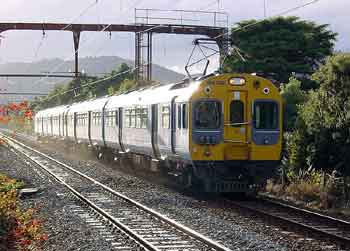 |
 |
||||
| Wellington's fleet of electric multiple units include some trains which are of Hungarian origin.
Image & license: Joseph Christianson / Wikipedia encyclopædia. CC BY-SA 2.5 http://commons.wikimedia.org/wiki/Image:Tranz_Metro_EMU_Wellington.jpg. |
Southbound train leaves Newmarket station, Auckland, during building works.
Image Ingolfson / Wikipedia encyclopædia. Public Domain http://commons.wikimedia.org/wiki/ File:Newmarket_Train_Station_Works_I.jpg. |
||||
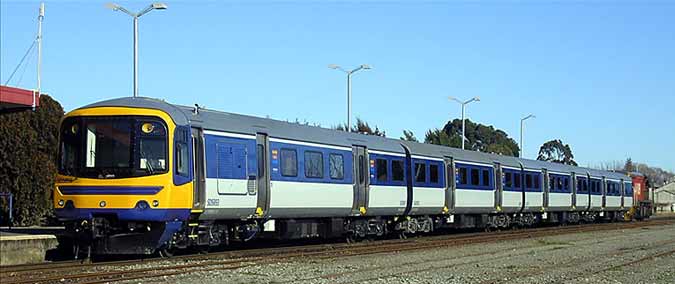
Converted former British Railways Mk2 carriages which now have suburban style sliding doors operating in 'push-pull' mode on local services in the Auckland area. The end carriages are also fitted with diesel generators, albeit only to power the on-train services (lights, doors, etc). Image & license: Palmeriain / Wikipedia encyclopædia. CC BY-SA 3.0 http://commons.wikimedia.org/wiki/File:SD_masterton.jpg. |
|||||
 |
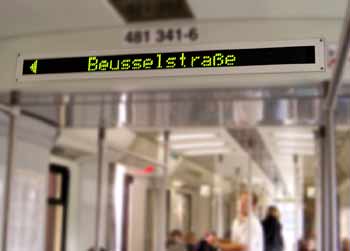 |
||||
| By 2005 restoration of most of the Berlin S-Bahn (suburban / city railway) and replacement of the vintage trains from the 1920's had been completed after the long "hibernation" of the post-war period when the city became divided and the system contracted. | Passenger information systems on the Berlin S-Bahn includes these dot-matrix displays which will even advise passengers on which side the doors will open at the next station. | ||||
Paris, France, has several marketing brands of urban / suburban railway services. These include "Transilien", which mostly involves trains that travel into mainline terminal stations around the centre of Paris, and the "RER" (regional express railway) which involves suburban trains that link up suburban railway routes on opposite sides of the city, mostly by means of new-build subterranean linking tunnels below the city centre. Together these serve the wider built-up area plus close communities which form what is known as the Île-de-France region of France. This is in addition to the Parisian métro, which primarily serves the part of the entire Parisian conurbation that comprises the historic city of Paris. Overseeing all transport operations and co-ordinating the different transport companies in the region is a body called STIF - Syndicat des transports d'Île-de-France. The name Transilien is a variation on the word Francilien, this being a term that is frequently used to describe the inhabitants of the Île-de-France region of France. |
|||||
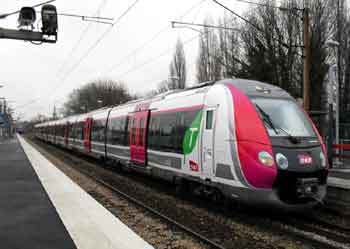
Image & license: Eole99 / Wikipedia encyclopædia. CC BY-SA 3.0 http://commons.wikimedia.org/wiki/File:Z50000_Groslay_versParis.JPG |
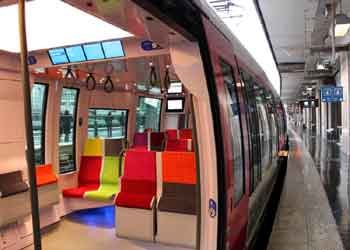
Image & license: Greenski / Wikipedia encyclopædia. CC BY-SA 3.0 http://commons.wikimedia.org/wiki/File:Z50000_-_Gare_de_Nord_(2).jpg |
||||
There are many different types of trains to be found on the Parisian railway network, these images show one of them.
Launched in 2009 the Z50000 trains are painted in a livery which combines elements from three transport organisations: the green leaf of Transilien, the red doors of SNCF and the long gray banner on each side of STIF. The internal view shows the multicoloured rainbow seating (some seats are folded up), some passenger information displays and one of the televisions. To maximise passenger capacity the French Z50000 urban / suburban trains feature articulated short-length passenger carriages of just 16.53m / 54ft 3in [end carriage], 13.24m / 43ft 5in [most intermediate carriages] and 8.29m / 27ft 2.5in [central carriage on shorter trains only]. Being shorter means that they need a less wide swept path on curved track, so as a result at 3.06m / 10ft 0.5in they are appreciably wider than more traditionally dimensioned types of train and which typically have carriages that are circa 24m - 26m / 79ft - 86ft in length and 2.89m / 9ft 5.5in in width. These trains come in two train lengths. Eight carriage trains seat 472 passengers, including 92 folding seats. The shorter seven carriage trains provide 380 seats, 74 of which are folding / tip-up seats. Thanks to the extra width of the train it is possible for some of these seats to be in 3 + 2 format and still maintain a central walkway between them that is 55cm / almost 22in in width. The seats are cantilever in design, which means that they only cling to the side walls, this creates space below them for luggage and also makes it easier for the cleaners to sweep the train's floor. As the images suggest, the seats are upholstered in a range of eight different colours, these being raspberry, gray, yellow, burgundy, orange, red, soft green and purple. The trains also feature blue coloured underseat lighting. This can be seen, reflected on the floor, in some of these images. As if that is not enough colour the ceiling lights in the areas between the doorways also vary the colours shown, with white being for when the doors are open, blue when the train is accelerating and orange when it is coasting or braking! Normally when in passenger service two such trains are coupled together to form one longer multiple-unit train; although it is possible to couple-up three such trainsets, if required. The two end carriages include space for passengers who use wheelchairs, pushchairs / buggies / strollers, etc., ie: personal wheeled transports. In addition elsewhere along the train is shared space for cycles, although this too requires the tip-up seats to be closed. The trains feature large double-glazed windows which provide 50% more glass area than the trains they replace. In addition to the gain in brightness, passengers benefit from clear unobstructed views of the outside at eye level. As the trains are fully air-conditioned the windows cannot be opened. This both prevents loss of air conditioning efficiency and the throwing of objects out of the train. In addition to real-time travel information displays these trains feature video screens which are located at carriage ends / one per each corner. These show the digital terrestrial television (DTT), cultural information, local weather; passengers must wear wireless headphones to listen. The trains are capable of operating from overhead wires energised at either 1.5 kV DC or 25 kV AC and have a top speed of 140km/h / 87mph. |
|||||
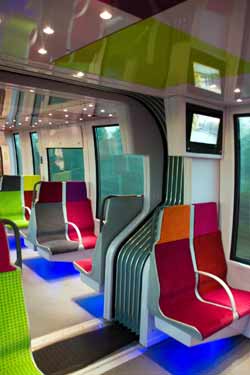
Image & license: Poudou99 / Wikipedia encyclopædia. CC BY-SA 3.0 http://commons.wikimedia.org/wiki/File:Z50000_12dec2009_IMG_6066.jpg |
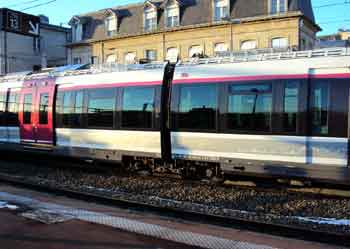
Image & license: Kirikou / Wikipedia encyclopædia. CC BY-SA 3.0 http://commons.wikimedia.org/wiki/File:Gare_de_Pontoise_-_mars_2013_-_Quais_(4).JPG |
||||
| The inside of a train at the articulated joint between two carriages. Also seen is a television screen - there are four of these located in each of the corners next to the articulated joints. | The outside of a train at the articulated joint between two carriages showing the shared Jacobs bogie and the indented body sides into which the doors slide when they are open. | ||||
These trains have been designed for various platform heights. All passengers benefit from level access at stations where the platforms are about 92cm above ground. To make life easier for passengers who use personal wheeled transports the doors in the two end carriages feature gap-fillers which automatically deploy so as to plug the approximately 10cm gap between the train and platform. When the trains call at stations with low height platforms (55cm or less) extending steps automatically deploy below all the train's doors. |
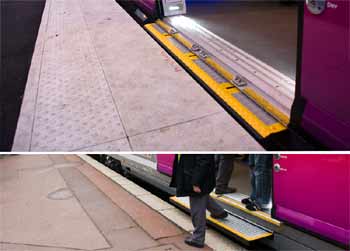
A composite image showing an extending gap-filler (upper image) and an extending step (lower image). Both images & license: Poudou99 / Wikipedia encyclopædia. CC BY-SA 3.0 Upper image: http://commons.wikimedia.org/wiki/File:Z50000_12dec2009_IMG_6002.jpg Lower image: http://commons.wikimedia.org/wiki/File:Z50000_12dec2009_IMG_6080.jpg |
||||
The RER is jointly operated by both the mainline railway (SNCF) and the citywide urban transport company that also runs the métro, funicular, trams and buses (RATP). Sometimes services are provided by trains which are in "Transilien" livery. |
|||||
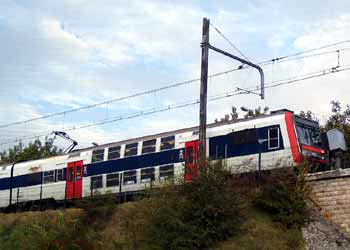
Image & license: BernardM / Wikipedia encyclopædia. CC BY-SA 3.0 http://commons.wikimedia.org/wiki/File:RER_C_Etampes.jpeg |
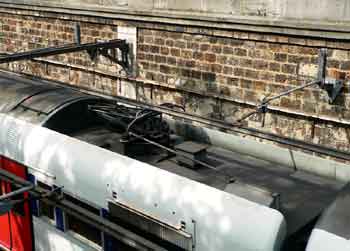
Image & license: David.Monniaux / Wikipedia encyclopædia. CC BY-SA 3.0 http://commons.wikimedia.org/wiki/File:Overhead_rail_P1220601.jpg |
||||
Because of restricted space (in the tunnels, under bridges, etc.,) only some Parisian RER lines are able to use double-deck trains, and in a few locations further space is saved by
the overhead power supply system using fixed (rigid) rails in place of flexible wires.
In an effort to maximise passenger loadings the S-tog trains in the Danish capital (Copenhagen) which date from 1996 use these revolutionary short wheelbase articulated walk-through trains that when first introduced totally re-wrote the "rule book" on modern train design. Short wheelbase single axle passenger carriages were known in the early days of the railways when passenger carriages emulated horse-drawn stagecoaches, but for various reasons fell out of favour when longer carriages with bogie wheelsets at each end became possible. To facilitate the extra width of these trains they use very short carriages which on bends neither stick out so much at the ends nor have the middle of the carriage 'cut the corner' on the inside. To reduce the trains' weight and consequential power consumption they are articulated and use single axles (2 wheels) instead of 'bogie' units (which usually use twin axles / 4 wheels). Most trains are constructed as 2x4-carriage units permanently joined together. The outer carriage (with the driver's cab) has a wheelset at each end whilst the other carriages have one wheelset of their own and partially 'hang onto' the previous carriage. Despite using single wheels the ride quality is very acceptable. |
|||||
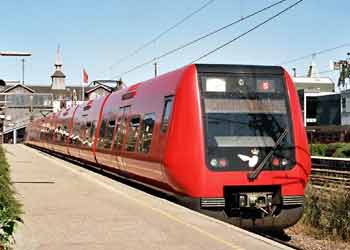 |
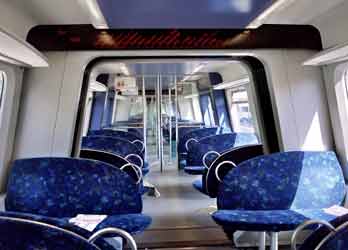 |
||||
| The revolutionary Copenhagen suburban trains. Each 8 carriage train is roughly the same length as a 4 carriage "conventional" train - but provides greater passenger capacity & comfort | Inside view showing the inter-carriage walk-through feature, see-through anti-draught internal screens (with powered sliding doors) and spacious 3+3 seating. | ||||
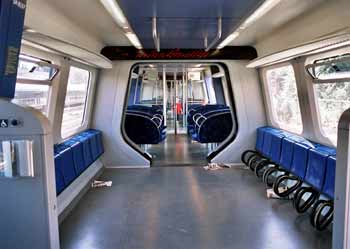 |
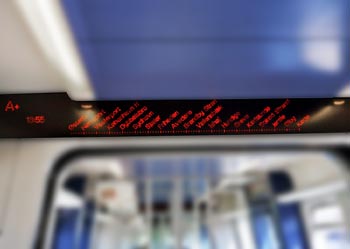 |
||||
| Some carriages feature fold-up longitudinal seating, space for wheelchairs & pushchairs and even bicycle hoops. Another internal view which shows the bicycle hoops more clearly can be found by clicking here. |
The red LED (light emitting diode) 'real-time' route information alters along the journey with the lower row of dots switching off as the journey progresses. | ||||
For those who would like more detailed information on these Danish trains: The driving carriages are 12m (metres) in length and the trailers 10m. The fleet consists of 136 trains; 105 of which have 8 carriages (and are known as Litra SA) and 31 of which have 4 carriages (and are known as Litra SE). At just under 84m in length an 8 carriage train is comparable in length to a 4 carriage version of the older trains. Especially at busier times two units operate in multiple, giving 16 carriages in total. These new trains are 3.6m wide (the older trains were 3.0m wide) and at 312 (plus 28 folding seats) they seat about 33% more passengers than the older trains - without the need for expensive lengthening of station platforms! In total 8 of the 10 axles per 8 carriage new train are motored, giving them a maximum acceleration rate of 1.3m per second and top speed of 120km/h (about 75 mph), although signalling or track limitations means that this speed is only reached on some routes. They are powered at 1650v DC and feature regenerative braking, reducing the energy requirement from the power station by approximately 40%. The shorter 4 carriage trains are a little under 43m in length, they offer 134 fixed seats plus 16 folding seats, Faced with rising traffic congestion the people of San Francisco USA did not want to emulate their southern Californian neighbours in Los Angeles who were trying (and failing) to solve traffic congestion through massive road building and after much discussion / campaigning the BART (Bay Area Rapid Transit) scheme developed. Opening in 1972 the system now boasts 44 stations over 104 route miles (approximately 167km) and includes a station serving San Francisco International Airport. Another feature is the Transbay Tube which runs under San Francisco Bay and is the longest underwater tube for an urban railway system anywhere globally. The tube itself is 3.6 miles (5.7 km) in length, although including the approaches from the nearest stations (one of which is underground) it totals 6 miles (9 km). At a maximum depth of 135' (41 m) below the surface it is also one of the deepest vehicular tubes known about in the public domain in service today. (Although the suggestions remain unsubstantiated it is possible / probable that the military have access to a 4000+mph [6400+km/h] maglev located approximately 4 miles [6.4km] below ground). The BART system is electrified at 1000 volts dc with the trains using a third rail power collection system. For rapid acceleration every axle (wheelset) is motored - making four motors per carriage. The trains feature an aluminum body, carpeting, air conditioning, tinted windows and are a generous 10' 6" (3.20m) wide, with an impressive 6' 9" (2.06m) headroom - which is just as well, with so many local people being over 6' (2m) tall! The actual length of trains varies between 3 and 10 carriages depending on line and time of day. The maximum speed was originally 80 mph (130km/h) with the average speed including 20 second station stops being about 33 mph (53km/h). Since 1976 the usual speed limit has been 70mph (110km/h) because on a fully loaded car the single disc per axle braking system will fail when making an all-friction stop from the former top speed. According to the Wikipedia Encyclopædia this was known right from when the system opened and another disc on each axle was recommended, but BART believed such a failure of the non-vital dynamic brake system would be rare. However there have been some failures and when this happens it creates a safety hazard. Being a brand new system which does not share infrastructure with any other rail operations it was decided to build the trains to a more generous specification than might otherwise have been possible and therefore the track gauge is 5' 6" (1.676m) compared to 4' 8" (1.435m) for standard railways / railroads; this would have been done because a wider track gauge is more suited to wider trains and usually provides a better quality of ride. Another possible reason for this wider track gauge is that it assures none of the private freight railways that BART will ever want to extend its services over their tracks, and prevents them from wanting running rights over tracks owned by BART. BART operates five different sets of services which mostly interleave so that much of the system is served by trains on two or more routes. Four of these share the Transbay Tube and at busy times (especially the rush hours) significant congestion occurs as the multiple lines vie for shared resources. In the longer term a second tunnel is planned. This will feature four tracks - two for BART and two for other rail services - including the proposed California High Speed Rail system. There is some debate as to whether BART is a subway/metro or a regional service. Some people suggest that its acts more like a regional commuter railway because whilst it links two cities (San Francisco and Oakland) with their hinterlands it was not designed to provide frequent local services. So whilst it is often thought of as a subway / metro the service it provides is more akin to London's Thameslink, the Paris (France) RER, the Berlin (Germany) S-Bahn (and others) except that it does not have to share its rights of way with other railway services. (NB: ' means foot; " means inches; metric conversions are approximate). |
|||||
Depending on the type of the carriage BART trains offer 64, 68 or 72 seats. At crush load each carriage can carry as many as 150 passengers (including standees). The aerodynamic nose cone which extends 5' (1.5 m) in length has become an iconic distinctive feature of the system. New trains are currently being designed, the first should be ready for testing in 2015 with full scale production in 2017. |
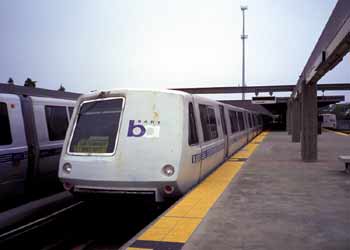
BART (Bay Area Rapid Transit) train. |
||||
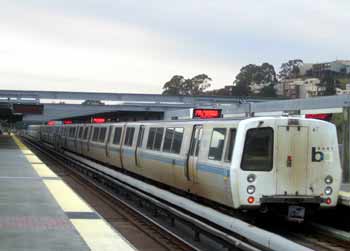
http://commons.wikimedia.org/wiki/Image:DalyCitysta.jpg |
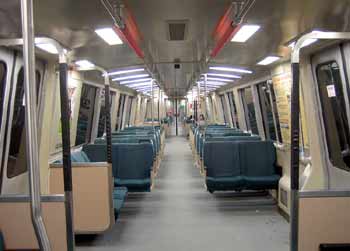
http://commons.wikimedia.org/wiki/Image:BART_B_interior.jpg |
||||
| Later batches of trains include some carriages with flat fronted driving positions which can be located within trains - this increases flexibility of operations and allows trains to be split (shortened) at locations other than the depots. | Inside a BART train.
Both images & licenses: lensovet / Wikipedia encyclopædia. CC BY-NC-SA 3.0 |
||||
Another form of 'short distance' trains are undergrounds, subways, métros and mini-métros. These are generally 'city-specific' transit systems which are operated by a specialist urban transit authority which often also runs the street-based transport (buses, etc,.) too. Most of these systems use traditional 'steel wheel' on 'steel track' technology however a few systems use trains that run on rubber tyres. This page makes no distinction The principal difference between a métro and mini-métro is that the latter will be designed for routes with lower traffic flows and therefore will use shorter trains. In other respects they are both more akin to 'heavy' rail in nature with fixed infrastructure, tunnels, etc., costing roughly the same to build except that where shorter trains are used there will be some savings in the cost of constructing the smaller stations. Sometimes métro and mini-métro trains will be able to negotiate sharper curves and steeper gradients than the other types of 'heavy rail' trains. As with the difference between 'light' rail (aka trams / streetcars) and 'heavy' rail the dividing line is indistinct - there are no fixed rules; instead the philosophy is that 'if it works / suits the location' then "fine". |
|||||
The first underground railway "anywhere" globally was the Metropolitan Railway which opened in London in 1863. |
|||||
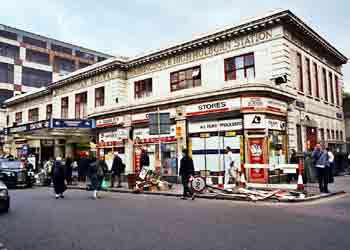 |
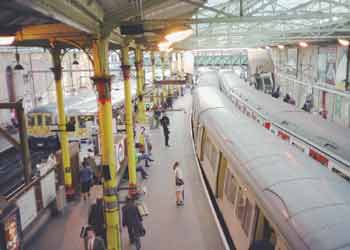 |
||||
| Farringdon station retains many of its original Metropolitan Railway features. | Thameslink and Underground trains at Farringdon station. | ||||
| Click either of the above images to see larger versions plus an extra view of the station in a popup window; alternatively clicking here will open the page in a new full-size window. |
|||||
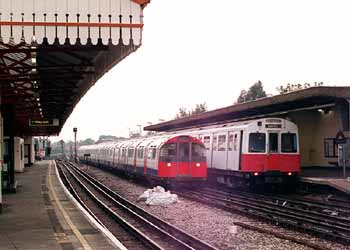 |
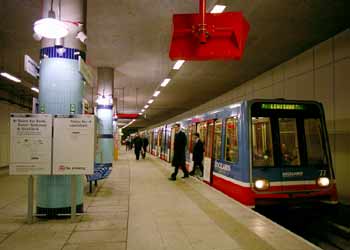 |
||||
| London's underground trains come in two different sizes - the smaller 'tube' trains and the larger 'mainline' size trains. This view was taken at a location where the 'tube' trains heading to Heathrow Airport provide an express service whilst the larger trains call at 'all stations'. | Also in London the Docklands light railway includes some underground sections. This is the new subterranean Island Gardens Station which was re-sited (from an elevated location) to facilitate the extension under the River Thames towards Greenwich and Lewisham. | ||||
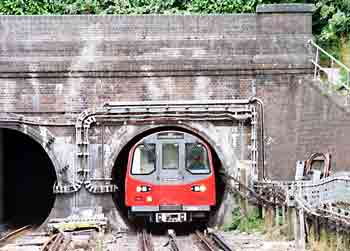 |
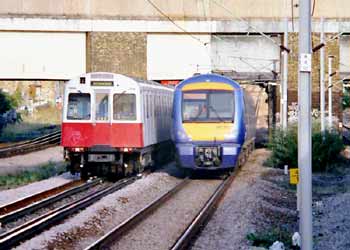 |
||||
| The nickname "Tube" comes from the almost circular tube-like tunnels through which the small profile trains travel. | As a contrast the larger profile trains are the same size as mainline trains. | ||||
Traditionally London Underground trains were painted red, however from the 1960's onwards all new trains featured aluminium sides that did not need painting to protect them against the weather. One small fleet of trains which date from the 1970's featured painted doors, this might have been to distinguish it from an earlier batch of similar rolling stock. One of the advantages of not painting the trains is that they then weigh less - and consume less energy. However, following problems in the 1990's with graffiti vandalism and a desire for a corporate image there was a rethink in policy and nowadays the trains painted red, white and blue. Even without the graffiti problem a change of policy would have been necessary. because nowadays disability legislation requires that train doors are painted in such a way as to easily discernable by people with limited vision. |
|||||
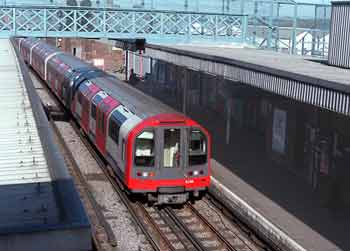 |
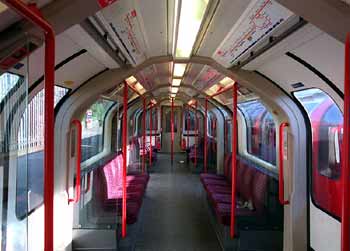 |
||||
| Small profile "tube" train as built in the early 1990's - these operate on the Central and Waterloo & City lines. Internally they only provide longitudinal seating as this maximises the amount of space available for standing passengers. These trains also feature full automated train operation although overall door control and starting the train after station stops still remains in the domain of a 'real person'. When built they were also fitted with passenger operated door open & close buttons as this would help keep the trains warmer when calling at surface stations in the winter months. Much to many passengers's dismay these buttons are no longer used, indeed train drivers can be disciplined for allowing them to be used, even though this is a feature which many passengers do want. No explanation has ever been given by management for this passenger-unfriendly policy. |
|||||
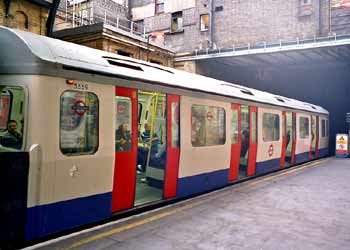 |
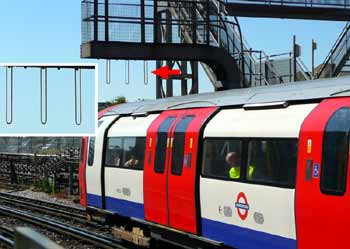 |
||||
| Large profile train as used on the Circle, Hammersmith & City and parts of the District Lines. These trains feature four pairs of double doors per train side for rapid entry / exit & minimum dwell time at stations. |
A surface stock train detector. These are located on tracks which lead into tube tunnels which are only suitable for small profile trains but on sections of track which could (inadvertently) also
be accessed by large profile (mainline sized) trains. As the image suggests, small profile trains pass under with ease; however larger trains will break the three elongated 'U' shaped glass tubes (which originally were filled with mercury but nowadays use aluminium foil) thereby breaking an electrical circuit and causing an automated trainstop device (such as is also used on the signalling system) to safely bring the train to a halt before it reaches the tunnel mouth. |
||||
Apart from London, Glasgow is the only other British city with a 'city specific' Underground railway. After London and Budapest (not illustrated) Glasgow became the third city "anywhere" globally to open an urban underground railway system. Built by the Glasgow District Subway Company it 1896 it is in the form of a 6.5 mile (approx 10.4km) circle with trains travelling both clockwise and anticlockwise. Because of Glasgow's geology the subway had to be cut with great difficulty through solid rock; this accounts for both the small size of the tunnels and why the system remains the same size as when it was first opened. Between 1936 and 2003 this system was officially called the Glasgow Underground, but the name has now reverted back to Subway. Between 1977 and 1980 services were suspended to allow for significant rebuilding / modernisation which included procuring brand new rolling stock and modification to the stations which amongst other things permitted longer trains. When the system reopened it was often affectionately nicknamed "Clockwork Orange" after the plain orange livery of the new trains, although at the time of writing (2005) they are being repainted in the carmine and cream (with a small orange stripe) livery seen here. In modern terminology the Glasgow Subway would be classified as a "mini-metro". This would be because when compared to mainline railway systems the Subway uses short 3 carriage trains of a smaller size which operate at much higher frequencies. As an aside, the subway is not the oldest underground railway in Glasgow itself; that distinction belongs to a 3-mile stretch of the North Clyde line which nowadays is part of the mainline ScotRail franchise and runs in a sub-surface tunnel under the city centre between High Street and Charing Cross (not illustrated). |
|||||
 |
 |
||||
With a tunnel diameter of 11' (3.35m) and track gauge of just 4' (1.22m) Glasgow Subway trains are even smaller than London's small profile "tube" trains.
Liverpool also has some underground stations but here too services are provided by inner-suburban mainline trains operating as part of a mainline rail franchise. Known as the Loop & Link the system features two lines - one where trains travel under Liverpool City Centre linking lines to the north and the south of the city and another where trains from Birkenhead and the Wirral peninsula travel in a clockwise loop around Liverpool City Centre before returning back under the River Mersey towards the Wirral. Whilst the Loop & Link opened in 1977 the tunnel under the River Mersey actually dates from 1886. It was built by the Mersey Railway - originally as a steam railway - and electrified in 1903, in the process seeing the Mersey Railway become the first steam railway "anywhere" globally to change over entirely to electric traction. |
|||||
 |
 |
||||
The Merseyrail system is centred on the city of Liverpool with most of the network forming an overground suburban railway serving the county of Merseyside and its close
hinterland.
The view on the left shows a train in the first Merseyrail livery after BR standard blue/grey was abolished. The person with his back to the camera is the guard whose duties include opening & closing the trains' doors as despite being an urban "local travel" railway all trains are still operated by two-person crews (a train driver at the front plus a guard at the back). The view on the right shows a refurbished train about to leave one of the city centre underground stations on the Loop & Link. The next train describer mentions train lengths because although usually trains operate in single unit (3 carriage) formations they can (and sometimes do) also operate as twin unit (6-carriage) trains. Dot-matrix signs and train destinations are not normally "captured" in their entirety by digital cameras but this subterranean view required a slow enough shutter speed to enable this. As with all other photographs taken on station platforms on this website this image was taken using a hand held camera without the use of a flashgun, which for safety reasons are strictly prohibited. This is to protect the eyes of the train drivers, which will be accustomed to the darkness of the tunnels - the use of flashguns on eyes which are accustomed to the dark can cause short-term blindness, which especially for someone who is driving can present a severe safety hazard. At one time similar 'city centre suburban mainline railway tunnel' systems were also planned for Sheffield and Manchester but it is understood that the people of Sheffield wanted to spend the available funds subsidising local bus fares whilst the national government point blank refused to provide sufficient investment funds for Manchester's scheme to be brought into reality. (It is said that the national government had declared "never again" after building the Tyne & Wear Metro's underground section, even though in Manchester the aim was solely to improve access to the city centre by merging two existing suburban electrified services which used edge-of-city-centre mainline railway so that they became one). Nowadays both cities have surface light rail systems - with Manchesters' Metrolink having started off as a street level variant of the failed Picc Vic Link which was so successful that it has been extended to other new destinations within the city, some of which re-use formerly closed railway routes. The Tyne & Wear Metro is a regional rail system based on the city of Newcastle-Upon-Tyne where some stations are underground. When it first opened (in 1980) most of the system was effectively a re-electrification of mainline services that the former British Railways converted to diesel trains in the 1960's, although the underground section was brand new construction. Although the Metro uses what are essentially light rail vehicles they are at the 'heavy' end of the scale, being designed to be compatible with mainline trains - a feature which has stood them in good stead for the 2002 extension to the nearby city of Sunderland, which is (mostly) over pre-existing tracks where the Metrocars provide local services and mainline trains operate longer-distance regional services. Light rail / trams are also (usually) seen as a type 'short distance' transport; to avoid making this page too large they are looked at on a dedicated Trams & Streetcars page. |
|||||
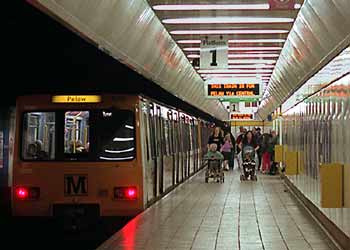 |
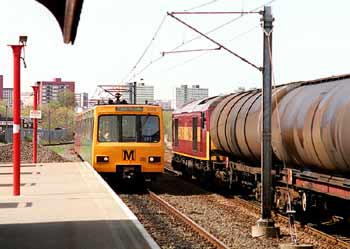 |
||||
| Tyneside Metrotrain calling at an underground station. From the outset the entire Metro system was designed to be pushchair (and wheelchair) friendly. |
Much of the southern part of the system sees the Metro sharing its alignment with mainline trains (as seen here). In 2002 some services were extended to Sunderland which was made possible by Metro trains travelling over tracks also used by mainline trains. | ||||
|
Of course Britain is not the only place with urban rail systems, but there are so many in major cities around the globe that it is only possible to mention a few of them. |
|||||
Another city (in addition to London) which has both "smaller" and "larger" profile underground railway trains is the German capital of Berlin. These three images show a recent type of train which was built in two versions depending on lines served. Note that only some of the train's doors are open - in Berlin (and unlike London) ALL the trains have "passenger operated doors" which
are opened by pressing illuminated buttons. Since reunification they also have audible & visible door closing alarms. |
 Small profile U-Bahn Berlin train of the type also seen below. |
||||
 |
 |
||||
Inside modern Berlin U-Bahn trains - large profile left and small profile right. Only the former has the overhead television-style display screens.
Full-width inter-carriage gangways also feature on metro trains in other European cities too... |
|||||
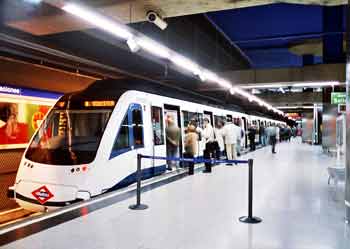 |
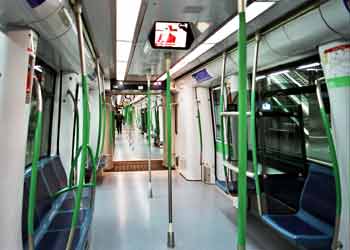 |
||||
| Madrid, Spain. Note the longitudinal seating and the television passenger information displays. | |||||
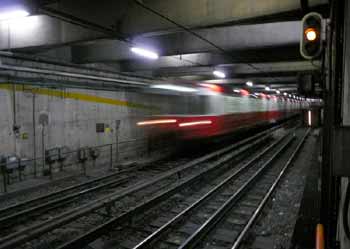 |
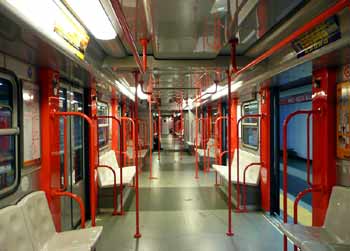 |
||||
| Milan Metro Line 1, Italy. As an aside, this is one of the very locations (apart from London) where a steel wheel railway line has been electrified on a 4 rail system. Even then there is a difference between here and London in that whereas for both cities the centre (negative) rail is located between the tracks and uses 'top contact', the outer (positive) live rail uses top contact in London and side contact in Milan. | |||||
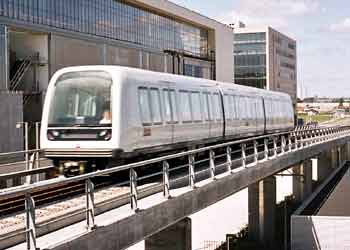 |
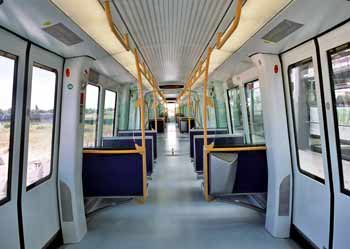 |
||||
A fully automated (ie: computer-driven and unstaffed) metro train in Copenhagen.
To avoid making this page too big automated (self driving) railway services are looked at on the Automated 'Driverless' Metro Systems page. Although transport systems have not traditionally been seen as being places of beauty there is no 'law' as such which requires that stations should be solely functional but visually mundane / utilitarian. Realising this, and that visually uplifting buildings represent environments where people may 'wish to be' many systems have built (at least some of) their stations with good design in mind. Sometimes this will add a comparatively small amount to the overall cost (often less than 1%) but it also helps attract passengers to the system and creates something which local people can be proud of. In the former Soviet Bloc nations politics also entered into the mix, with the cities deemed to be more important being given impressive stations that were designed along the theme of Palaces of the People. Often these featured valuable materials - such as different coloured marble and semi-precious gem stones sourced from various parts of the Soviet Empire, and were lit using chandeliers, adorned with mosaics, paintings, etc., so that they would often rival many an ancient stately home, chateau, art gallery etc. Nowadays when building new systems or extending existing systems some cities employ architects of the highest calibre from around the globe, with the express intention of their designing stations to a cutting edge artistic brief - and apart from attracting passengers who just wish to travel from A to B these stations often also attract a global audience of students plus other people whose primary interest is in design & architecture who wish to see and photograph these visually distinctive buildings (stations). For similar reasons some systems also include works of art in their stations - busts, sculptures, bronze figures, stained-glass windows, etc. It is only the intention of this page to mention this aspect of station design 'in passing', and even then only with respect to short distance urban transport railways. Further information and many photographs
can be found on this excellent page at the Metro-Bits website |
|||||
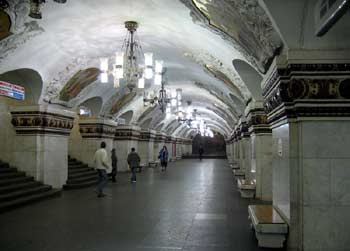 |
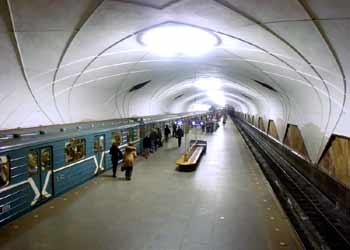 |
||||
| The Moscow, Russia metro is famed for its Palace of the People stations. This is Kievskaya.
Image: Wikipedia encyclopædia. Image subsequently deleted from Wikipedia because of lack of freedom of panorama in Russia. http://commons.wikimedia.org/wiki/File:KievskayaAPL-mm.jpg. |
Some stations in Moscow have been built to a 1930's 'art deco' design. This is the airport station.
Image & license: Aborisov / Wikipedia encyclopædia. Public Domain. http://commons.wikimedia.org/wiki/File:Aeroport_metro_station_Moscow_2.jpg. |
||||
Two Metros In Moscow??? Although not (yet) confirmed officially it has been suggested that Moscow has a second metro system at a deeper level than the public system. This is said to be under military jurisdiction and was built to facilitate survival during a war / natural disaster and to act as a secret escape route for key personnel, should it ever be needed. The only sort of validation which could be said to be in the public domain comes from other cities - such as Prague, Czech Republic - where rumours which talked of similar during the Soviet era were later found to be true, although the facilities were considerably less extensive than the rumours had led people to expect they would be. For the record, rumours also exist of a planet-wide deep level high-speed maglev system which links subterranean military bases and other facilities in the USA, Australia, etc. |
|||||
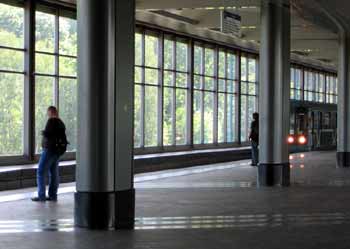 |
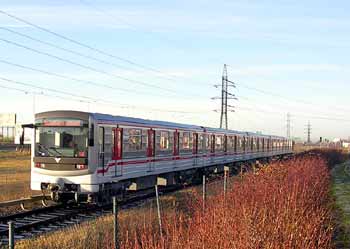 |
||||
| Vorobyovy Gory station on the Moscow metro is noteworthy because it is located on the lower level of a double deck bridge (over the Moskva River), being the only example of such anywhere globally.
The platforms are accessed from both river banks. As is seen here, the station is also weather protected with windows.
Image & license: Andrey Volykhov / Wikipedia encyclopædia. CC BY-SA 3.0 http://commons.wikimedia.org/wiki/File:Vorobyovy_Gory_subway_4.jpg. |
For many years the planned economy of the Warsaw Pact nations saw the same trains (rolling stock) being used in many cities throughout the Soviet Bloc. One distinguishing feature of these trains was
their corrugated metal sides. Nowadays however many cities are buying rolling stock of different designs, although where trains are still relatively modern they are refurbishing rather than replacing them.
This refurbished example comes from Prague, Czech Republic.
Image & license: User: ŠJů / Wikipedia encyclopædia. CC BY-SA 3.0 http://commons.wikimedia.org/wiki/ File:Zku%C5%A1ebn%C3%AD_kolej_Zli%C4%8D%C3%ADn.jpg. |
||||
The Flood RiskIn August 2002 heavy rains and consequential rivers bursting their banks resulted in severe flooding of large areas of Central Europe, and that included a large portion of the Prague metro. So severe was the damage that it took until March 2003 for the system to fully reopen. The reasons why this occurred are not for this page to discuss, however with climate change (and more) in mind it is to be hoped that every conurbation which has an underground railway / metro / subway system has adequate and working flood protection systems, and would remember to use them if there was a credible risk of a flood event. There would be nothing worse than trains full of passengers becoming stranded in deep level tunnels which are filling up with water. The risk is equally severe in cities where tectonic activity is a known issue (San Francisco, Japan), as it is in any city where there are rivers / waterways - including London, Liverpool, New York, Boston, Berlin, Paris, Singapore, Sydney, etc. |
|||||
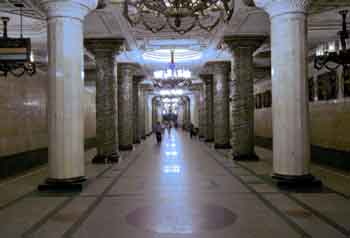 |
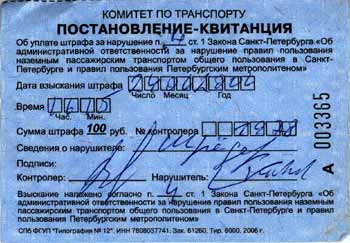 |
||||
| Another Russian Palace of the People - this is Awtowo in St Petersburg. The person who photographed this station was fined 100 Rubles for doing so (see right). This is indeed most regrettable, as tourists flock to St Petersburg to see its fine works of art - and this includes the metro! Fines such as this 'simply for using a camera' will make the tourists think about going elsewhere. Image & license: MatthiasKabel / Wikipedia encyclopædia. CC BY-SA 2.5 http://commons.wikimedia.org/wiki/ File:Metropolitain_of_Saint_Petersburg_station_Awtowo.jpg. |
This suggests that the transport officials have something to hide / are ashamed of their stations, and is in fact a curse which blights many urban transport systems globally. Of course some petty officials will cite 'security' as a reason for banning passengers from taking photographs at stations - but maybe they have never heard of (or seen) shirt button camera systems, jacket lapel badges and eye glasses with embedded cameras? Simplistic petty rules only harm the innocent - they will not stop photography with malicious intent! Image & license: MatthiasKabel / Wikipedia encyclopædia. CC BY-SA 3.0 http://commons.wikimedia.org/wiki/ File:Ticket_for_photographing_Petersburg_Metro.jpg. |
||||
Contradictory Camera Policy / Breach Of Human RightsThe use of either overt or covert surveillance systems to film places to where the public are admitted whilst at the same time banning the public from using their own cameras represents a breach of human rights. No person should have the right to do something in the public domain that does not require specialist safety training* whilst preventing other people from doing the same thing.(*the proper and safe use of a camera does not require special safety training). |
|||||
When stations are entirely below ground potential passengers need a way of knowing that the station is there!
|
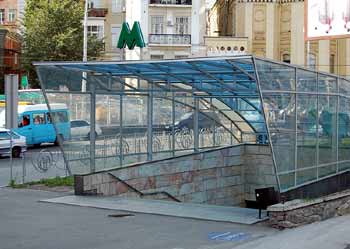
The entrance to Palac Sportu station on the Kiev, Ukraine Metro. Image & license: Andrjus Shyaulis / Wikipedia encyclopædia. CC BY-SA 3.0 http://commons.wikimedia.org/wiki/File:Palac_spotru_external.JPG . |
||||
Stations which are 'under the ground' need to be linked with the surface, and for the majority of stations this is usually done by means of moving stairways - aka: escalators.
|
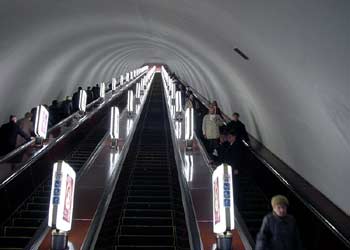
The bank of four escalators at Teatralna metro station in Kiev, Ukraine. Image & license: Jason Minshull / Wikipedia encyclopædia. CC BY-SA 3.0 http://commons.wikimedia.org/wiki/File:PhotoOfTeatralnaStation.jpg. |
||||
|
In Boston, Massachusetts USA they colour-code their urban transports according to the line on which they operate. For the subway there are four lines (Red, Orange - which I was advised serves some of the best avoided areas of the city - Blue and Green). The first three of these use 'proper' subway type cars and contrary to the international 'norms' feature red marker lights at both the front and the rear of the trains. The Green Line uses street compatible streetcars and instead features green marker lights at the front. Other colour-coded lines include "Purple", which is used for heavy rail commuter trains and "Silver", which is used for a Bus Rapid Transit Trackless Trolley service ("trolleybus" in British English) which also includes both surface and subterranean operations. |
|||||
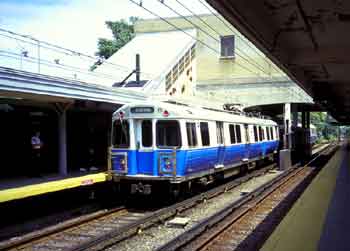 |
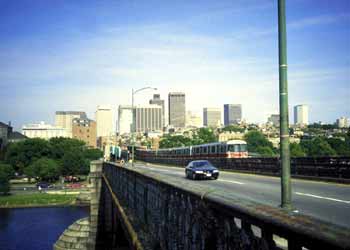 |
||||
| Boston's Blue line features twin system trains that collect power from an electrified 3rd rail while below ground and overhead wires when on the surface. The changeover point is at the station for the airport - which is where this train was when the photograph was taken. | A Red line train crosses the Longfellow Bridge over the Charles River which links Boston with the neighbouring city of Cambridge (Mass), this being where the globally-renown Harvard University is located. At Harvard station there is interchange with one of Boston's two bus 'subway' systems. | ||||
|
The tracks of Toronto's subway and streetcar networks (but not the Scarborough RT) are built to the unique gauge of 4ft 10 7/8in (1,495mm) rather than the usual standard of 4ft 8 1/2in (1,435mm). Although there are several theories there is no definite known reason for this, although it may be significant that the use of this gauge was established in 1861 (for the streetcars), this being ten years before Canada's adoption of standard gauge for rail systems. Although the subway system only dates from the 1950's it may be that the same track gauge as the streetcars was chosen because at one time serious consideration had been given to running streetcars through the tunnels and possibly having some subway routes run partially in tunnels and partially on city streets (possibly with the streetcars). Bearing in mind the cost of converting all the tracks and vehicles (and the lack of any real benefit in doing so), the unique gauge has remained to this day. The use of standard-gauge tracks on the Scarborough RT makes it impossible for there to be any track connection between it and the other lines, and so when its vehicles need anything more than basic maintenance they have to go by road to the suitably equipped subway maintenance facility. The Scarborough RT service is an automated urban transit and therefore is seen on the Automated 'Driverless' Metro Systems page. |
|||||
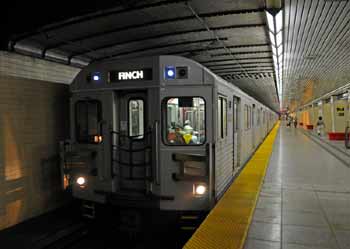 |
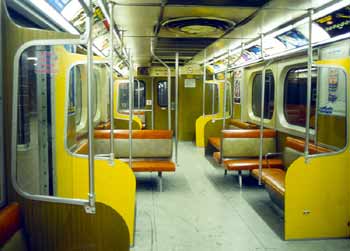 |
||||
| Toronto Subway train. The corrugated metal bodywork is typical for many North American (and Russian / former Soviet) systems. Back in 1954 when Toronto's
still-expanding subway was first opened they used British built trains which were painted red like those on the London Underground.
Image & license: archer10 / Flickr. CC BY-SA 2.0 http://www.flickr.com/photos/22490717@N02/2821366064. |
Inside an older Toronto Subway car showing the (orange vinyl) bench type of seating which many trains used to have. By looking through the car end windows which are to the left of the train driver's cab it is possible to see the inside of the tunnel. | ||||
|
Traditionally Toronto's subway trains have always featured half-width train driver's cabs, with passengers also being able to sit at the front and enjoy a clear view of where the train is going. However the newest trains (2009) do not offer this facility. Also deprecated are the corrugated metal sides. |
|||||
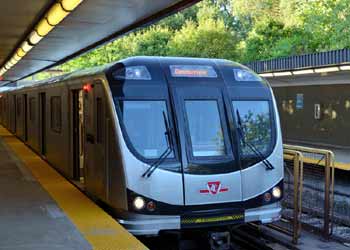 |
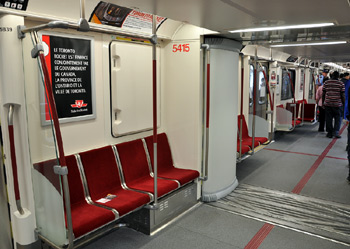 |
||||
| A Red Rocket Toronto Subway train at Rosedale station. The full-width drivers' cabs and sloped front end are new design features. Image & license: CCC2012 / Wikipedia encyclopædia. Public Domain. http://commons.wikimedia.org/wiki/File:Toronto_Rocket.JPG. |
Toronto Subway's newest trains are of a full walk-through design; this image includes the inter-car articulation. Note the uniformed security guard looking towards the photographer.
Image & license: Reaperexpress / Wikipedia encyclopædia. CC BY-SA 3.0 http://commons.wikimedia.org/wiki/File:TR_Articulation_1.jpg. |
||||
On the island-state of Singapore they use what effectively is a high-capacity urban rapid transit metro as the basis for a still expanding regional transport system. In Singapore city itself the trains operate underground; elsewhere they mostly operate on viaduct. Internally the air-conditioned trains are designed for crush loads with just limited longitudinal seating and plenty of standing space. To encourage passengers to travel in less crowded parts of the train they all feature full-width inter-carriage gangways. |
|||||
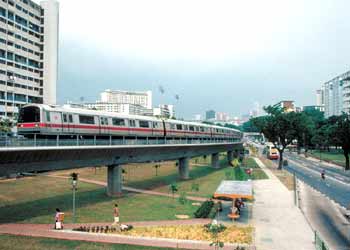 |
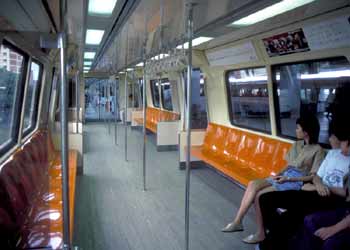 |
||||
| Elevated trackage in Singapore. | Inside a fully articulated Singapore Mass Regional Transit train. | ||||
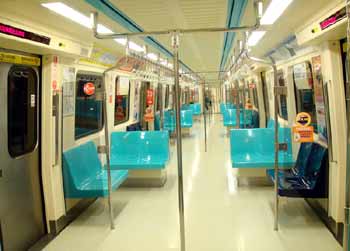 |
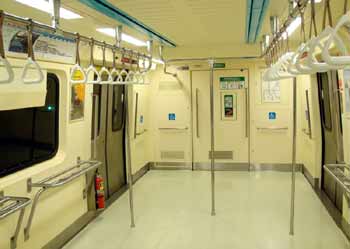 |
||||
In Taiwan some trains include carriages with provision for seated passengers and carriages without seats for 'standing-only' passengers.
Both images & license: Copyright © mailer_diablo / Wikipedia encyclopædia. CC BY-SA 3.0 Left: http://commons.wikimedia.org/wiki/File%3AC371-transverse.JPG Right: http://commons.wikimedia.org/wiki/File%3AC371-standing.JPG. Bangkok, Thailand is a very large city where traffic congestion is such that gridlock is commonplace. Whilst it does have some rail-based urban transport the system is not as nearly as extensive as large conurbations in countries such as Japan, China, Singapore etc. The trains are also a rather short 3 carriages in length. |
|||||
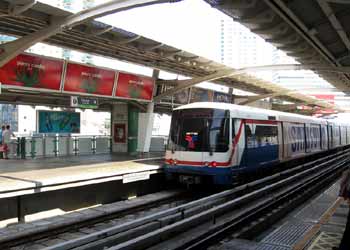 |
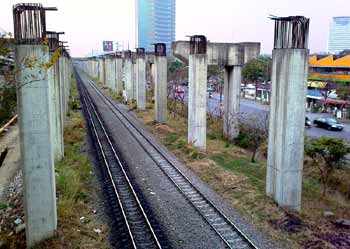 |
||||
| Bangkok Skytrain train leaving Asok Station for On Nut.
Image & license: Cdha / Wikipedia encyclopædia. Public Domain http://commons.wikimedia.org/wiki/File:Train_leaving_Asok_Station.jpg. |
Some of the 1000 part-built concrete pillars which remain from a failed transport scheme, as described below.
Image & license: Paul_012 / Wikipedia encyclopædia. CC BY-SA 3.0 http://commons.wikimedia.org/wiki/ File:Hopewell_pillars_2,_Bangkok,_2009-01-21.jpg. |
||||
The 1997 Asian financial crisis is often blamed for the failure of one combined road and urban railway transport scheme (which was to be located over State Railway Thailand tracks), resulting in over 1000 part-built concrete pillars littering the planned routes, sections of which were subsequently blocked by the building of a new elevated toll road. In March 2012 thieves stole metal scaffolding helping to hold up a structure which had been involved in weight testing. As a consequence a few months later some of the concrete beams then fell onto the railway tracks below them. |
|||||
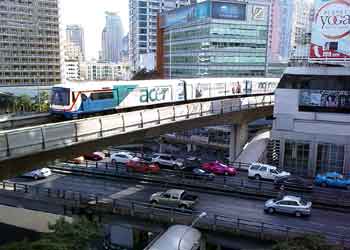 |
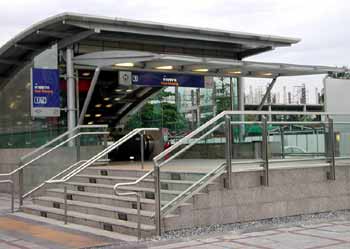 |
||||
| BTS Skytrain over Sala Daeng Intersection. Note the all-over advertising livery. Image & license: Paul_012 / Wikipedia encyclopædia CC BY-SA 2.0 http://commons.wikimedia.org/wiki/ File:BTS_Skytrain_over_Sala_Daeng_Intersection.jpg. |
Bangkok is on a low-lying plain which is prone to flooding so to protect against water inundating the subterranean MRT (Mass Rapid Transit - which is sometimes referred to as the Bangkok Metro) the station entrances are raised about one metre above the
ground level and equipped with built-in floodgates. This is Huay Kwang station.
Image & license: Waerth / Wikipedia encyclopædia. CC BY-SA 3.0 http://commons.wikimedia.org/wiki/File:HuayKwangstation.jpg. |
||||
Rubber tyred Metro systemsWhilst most urban railways use conventional steel wheels running on steel rails, a few use rubber tyred wheel systems. Although rubber tyred trains had already existed on the mainline railways, the French city of Paris is credited as having pioneered the use of rubber tyres on urban transport systems. The impetus behind this is said to be that at the end of WW2 the many years of heavy use but relatively little maintenance had left the métro system in a very run down condition and converting to rubber tyres was thought to be a way in which the system could be renovated and rejuvenated. The first Parisian rubber tyred train was introduced in 1951. Experimental in nature it operated a shuttle service between Porte des Lilas - Pré St Gervais over a section of track that was not in public service. The line closed again in 1961, although it is now proposed to re-open it as part of a new métro line. In 1956 line No.11 became the first full line to be converted. It was chosen because of its steep grades. Since then another three lines have been converted to rubber tyred trains, these being Nos. 1, 4, 6. Line 6 was converted in 1974 to cut down noise on its many elevated sections. However converting existing rail-based lines proved to be a very expensive process and is no longer done. For the record, whilst line 14 also uses rubber tyred trains this is because it was built this way from the outset. More information about rubber tyred metros and their genesis can be found here:
Nowadays métro trains using French rubber tyred technology operate in half a dozen French cities as well as several major global cities including Montréal Canada, Chicago USA, Santiago (Chile), Taipei, Taiwan / China and Mexico City. Other rubber tyred systems also exist, especially in Japan and with short distance airport people-mover systems. Whilst there are several variants in the implementation of rubber tyred systems, the core theme is for the rubber tyres to use twin parallel rollways, each of which will be the width of a tyre. Depending on city and the system builder these are typically formed of concrete, H-Shape hot rolled steel, or flat steel. Some systems also locate regular railway track between the rollways and the vehicles also have railway-style steel wheels with larger (taller / deeper) than normal flanges. In normal use these will be at small distance above the rails, their primary function being for guidance at points (switches/turnouts) and crossings. They are also needed in the case of a flat tyre. In Paris the steel rails also enabled mixed traffic with rubber-tired and steel-wheeled trains using the same track, particularly during the conversion periods. This use of two systems operating in parallel increases building / installation and maintenance costs. Systems without these tracks use other solutions for dealing with flat tyres and switching tracks at junctions. The essential difference between rubber-on-concrete and steel-on-steel is that rubber-on-concrete generates more friction. This increased friction results in various advantages and disadvantages... Advantages of using rubber-tyred trains (compared to steel wheel on steel rail):
Disadvantages of using rubber-tyred trains (compared to steel wheel on steel rail):
Rubber tyres have higher wear rates and therefore need more frequent replacement. Although a pair of steel wheels are more expensive than a pair of rubber tyres, the frequency of their respective replacements makes rubber tyres the more expensive option. In addition, additional rubber tyres are needed for guidance using the side rollers. In tunnels heat dissipation can be an issue as eventually all traction energy consumed by the train - except any electric energy regenerated back into the power supply system during braking - will end up as heat. Often this necessitates ventilating the tunnels. For fire resistance reasons the tyres are inflated with nitrogen. Some rubber tyred systems use single axle wheelsets flanked by side-facing guidance wheels, others copy normal 'steel wheel' railways and use twin axle bogies - which are also flanked by side-facing guidance wheels. |
|||||
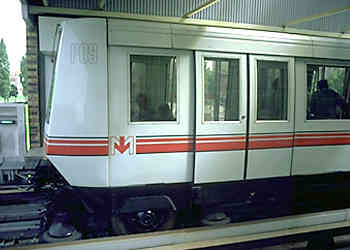 |
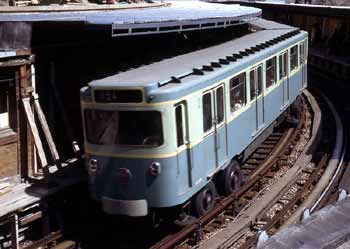 |
||||
| The French VAL system uses single axle technology. This image comes from Lille; more about the automated (self driving) VAL system can be found on the Automated 'Driverless' Metro Systems page. | When Paris, France first started using rubber-tyred trains its trains used twin axle technology, as per most steel-wheel railways. This view shows the original MP 59 rubber tyred trains at Bastille station in 1963.
Image & license: jhm0284 / Wikipedia encyclopædia. CC BY-SA 2.0 http://commons.wikimedia.org/wiki/ File:JHM-1963-0074_-_Paris,_m%C3%A9tro_ligne_1,_Bastille.jpg |
||||
As the VAL system does not include steel tracks and wheels so to ensure correct route selection at junctions it uses a centrally located guidance rail. Away from junctions the mere presence of the side guidewalls is sufficient to provide the required steering functions. By way of contrast, the entire rubber tyred network on the Parisian métro was designed to also be suitable for steel wheel trains and at junctions guidance is obtained by lowering the rubber tyre rollways so that the steel wheels engage the metal tracks and the trains are steered in the traditional railway way, which is by the wheel flanges. |
|||||
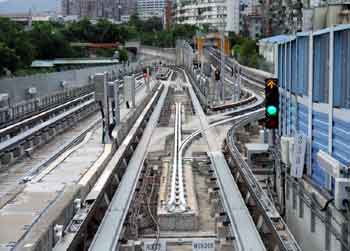 |
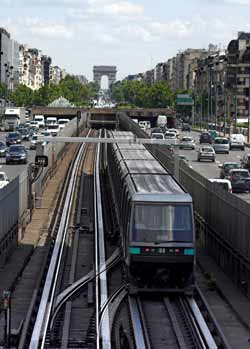 |
||||
| VAL style switch / turnout / points as seen on the Taipei Metro Wenhu Line between ZhoneShan Jr. High School Station and SongShan Airport Station.
Image & license: Shih-Han Lin / Wikipedia encyclopædia. CC BY-SA 2.0 http://commons.wikimedia.org/wiki/File:NeiHuLine_Point.jpg. |
A crossover on the rubber tyred Parisian métro Line 1. In the distance is the Arc de Triomphe de l'Étoile. Image & license: Lukke / Wikipedia encyclopædia. CC BY-SA 3.0 http://commons.wikimedia.org/wiki/File: Paris_Metro_line_1_view_from_Esplanade_La_Defense.jpg. |
||||
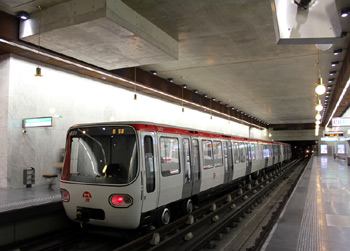 |
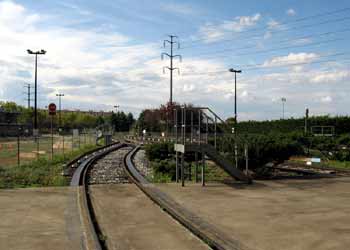 |
||||
| Lyon métro train at Line B termunus of Gare d'Oullins. Trains from the same fleet are also used on Line A. Image & license: Ibou69100 / Wikipedia encyclopædia. CC BY-SA 3.0 http://commons.wikimedia.org/wiki/File: 631_TCL_Alstom_MPL75_Metro_B_Gare_Oullins_Mai_2014.JPG |
This roadway crossing at the exit from the depot in Lyon, France is about the nearest a rubber tyred métro train will normally get to travelling on a 'normal' road. Without the upstanding guide bars the steel wheels are essential for ensuring that
the train follows its correct pathway over the crossing.
Image & license: Romainbehar / Wikipedia encyclopædia. Public Domain. http://commons.wikimedia.org/wiki/File:Lyon-Metro-D-Atelier-Thiolley-Sortie.jpg |
||||
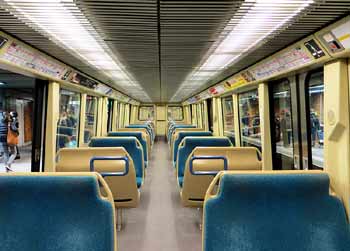 |
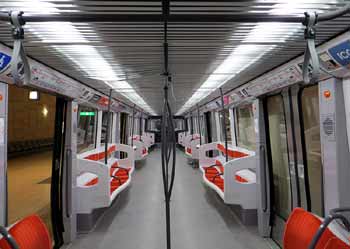 |
||||
| Inside a Lyon métro Lines A and B train when new.
Image & license: Sokl / Wikipedia encyclopædia. CC BY-SA 3.0 http://commons.wikimedia.org/wiki/File:Rame_non_rénové_en_2013.JPG |
Inside a Lyon métro Lines A and B train after being refurbished and given a radically different seating layout.
Image & license: Sokl / Wikipedia encyclopædia. CC BY-SA 3.0 http://commons.wikimedia.org/wiki/File: Rame_de_m%C3%A9tro_des_lignes_A_et_B_r%C3%A9nov%C3%A9.JPG |
||||
Apart from Paris and Lyon the only other French city to have a rubber tyred métro system which uses twin axles is Marseilles. More information about the several French (and other nation) métro systems which use the single axle VAL system can be found on the Automated 'Driverless' Metro Systems page. |
|||||
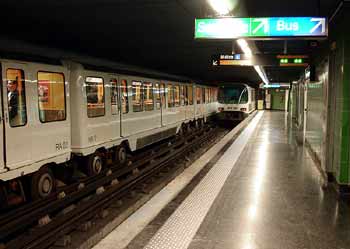 |
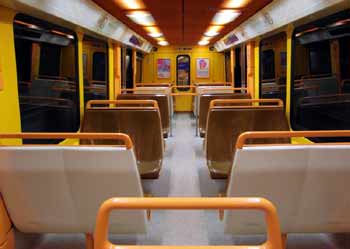 |
||||
| Marseilles métro trains at La Timone station.
Image & license: Clicsouris / Wikipedia encyclopædia. CC BY-SA 3.0 http://commons.wikimedia.org/wiki/File:Metro_de_Marseille_-_La_Timone_02.jpg |
Inside a Marseilles métro train.
Image & license: IngolfBLN / Wikipedia encyclopædia. CC BY-SA 2.0 http://commons.wikimedia.org/wiki/File:Marseille_-_Inside_Metro_(7537658024).jpg |
||||
Inspired by events in Paris, which at the time was converting some métro lines to rubber - tyred operation, the Montréal Canada métro - which opened in 1966 - became the first 'new build' system to choose rubber tyred technology. Being a more modern métro system it was engineered to avoid the sharp curves that are a feature of its Parisian rôle model; this allows the trains travel more quickly between stations and gives it an overall higher 'average' speed (ie: the total 'point to point' speed which includes the time spent during station stops). To reduce weather disruption in the severe and very snowy winters, the Montréal métro is fully enclosed with almost all the system underground - although some stations were designed to allow natural daylight to reach the platforms. |
|||||
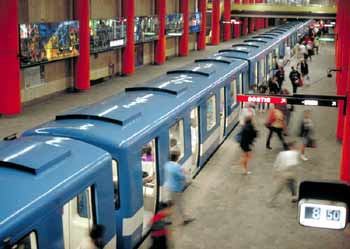 |
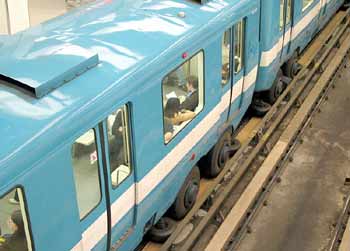 |
||||
| The Montréal Canada métro. | A close-up of the wheel units which from this elevated viewpoint clearly shows how the side roller wheels fit inside the guiderail.
Image & license: GK tramrunner229 / Wikipedia encyclopædia. CC BY-SA 3.0 http://commons.wikimedia.org/wiki/File:MontrealMetroTires.JPG |
||||
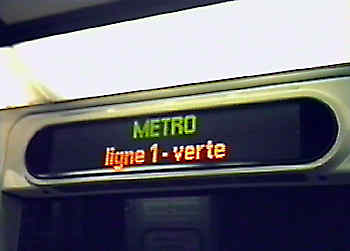 |
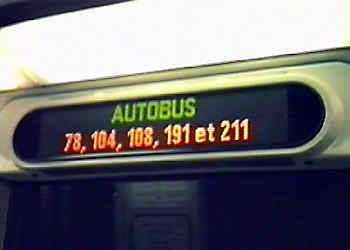 |
||||
Real-time passenger information display system inside the Montréal métro trains. Information supplied includes the name of the next station and (as here) interchange possibilities.
When not showing travel information the displays show other local information, news, weather forecasts, etc., and paid advertising.

A video showing this system in use has been placed on the 'youtube' file-sharing website and can be watched (in a new window) by clicking either the projector icon or this link - http://www.youtube.com/watch?v=HG_zyodzp7g The French have also sold rubber tyred métro technology to a few others cities, sometimes with these cities also using localised variants of the same types of rolling stock that were being built (at the time) for the Parisian métro. |
|||||
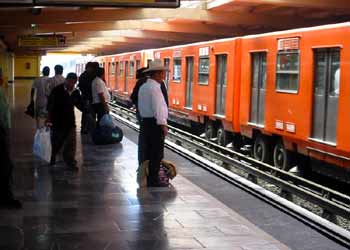 |
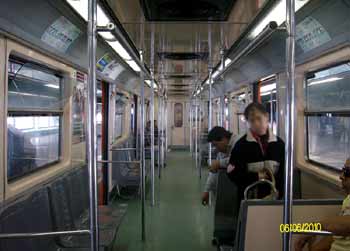 |
||||
| Rubber tyred métro train at Laraza station in Mexico.
Image & license: Tjeerd / Flickr. CC BY 2.0 http://www.flickr.com/photos/76396789@N00/755225. |
Inside a rehabilitated / refurbished Mexico City métro train type NM-73B CAF.
Image & license: Francisco Public Domain http://commons.wikimedia.org/wiki/File: Interior_de_un_NM-73B_con_cabina_CAF_rehabilitado _por_T%C3%A9cnicos_Mexicanos_del_STC.jpg. |
||||
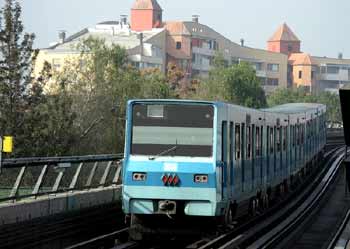 |
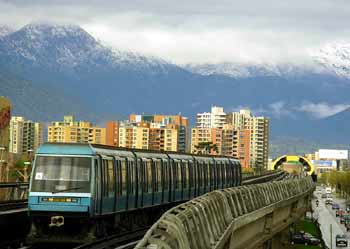 |
||||
| Santiago (Chile) métro Line 5 train type NS74, which is the same as the Parisan MP73 Image & license: Ariel Cruz Pizarro / Wikipedia encyclopædia. CC BY 2.0 http://commons.wikimedia.org/wiki/File:NS74_L5_MetroStgo.jpg. |
Santiago (Chile) métro Line 5 train type NS93, which is the same as the Parisan MP89 Image & license: Ariel Cruz Pizarro / Wikipedia encyclopædia. CC BY 2.0 http://commons.wikimedia.org/wiki/File:NS_93,_Metro_de_Santiago.jpg. |
||||
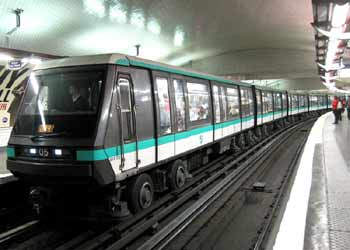 |
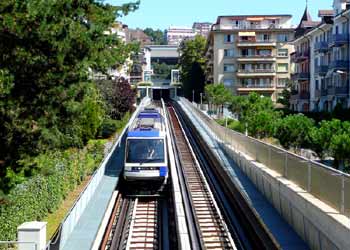 |
||||
| Parisian MP89 métro train at Nation station before Line 1 was converted to full unattended automation and the station was fitted with platform screen doors.
Image & license: Pline / Wikipedia encyclopædia. CC BY-SA 3.0 http://commons.wikimedia.org/wiki/File:Ligne-1-Nation-2.jpg. |
Lausanne (Switzerland) MP89 TL métro Line 2 trains are also clones of Parisian MP89 métro rolling stock, albeit with fewer carriages. The Lausanne system was fully automated with platform screen doors right from the outset. | ||||
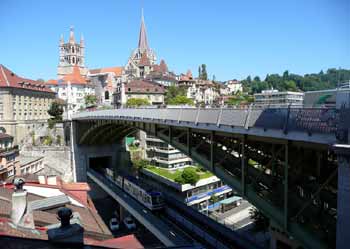 |
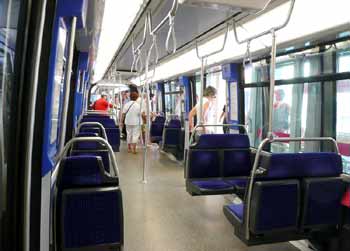 |
||||
| When Lausanne métro Line M2 was built it included constructing a railway bridge under an existing road bridge. The Bessières road bridge and the St-Martin railway bridge plus the Cathedral of Notre Dame in the background. |
Inside a Lausanne M2 métro train. | ||||
| |||||
| Detailed inspections of the Lausanne métro Line M2 tracks. Left: Guide bar, rollway and steel wheel rail. The surface of the rollway is ribbed, this is to wick water away and assist with adhesion on this steeply graded line. In addition to the normal braking systems these trains have powerful magnetic track brakes which form part of the emergency braking system and are also used at station stops to ensure that the train does not move whilst passengers alight and then board. Middle: Close up view showing an expansion joint which allows the tracks to expand / contract according to seasonal air temperatures. Photographed through a glass wall. Right: This image taken at the southern terminus and lakeside resort station of Ouchy includes an end-on view of the angle iron guide bars and the I-beam rollways which are an integral part of the track system. In the distance another train can be seen approaching. Photographed through a glass wall. |
|||||
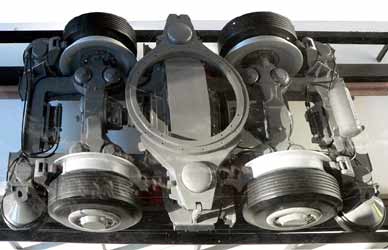 |
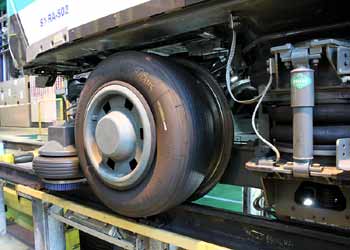 |
||||
| A bogie (wheel unit) for a Paris métro rubber tyred train which includes steel-wheel railway track capability.
Image & license: Rama / Wikipedia encyclopædia. CC BY-SA 2.0 FR http://commons.wikimedia.org/wiki/File:Bogie-metro-Meteor-p1010692.jpg |
Close up front wheel unit of a rubber tyred métro train above an under-train inspection pit in the depot. The train is using the steel rail wheels with just fresh air directly below the rubber tyre.
Also note the blue coloured brushes on the underside of the front side-facing guidance wheel.
Image & license: greenski / Flickr CC BY-SA 2.0 http://www.flickr.com/photos/35885802@N00/3972076887/ |
||||
In Japan there are almost a dozen rubber tyred systems, these use home-grown technologies. Sapporo's Nanboku Line opened in 1971 when it became the first such system to use a central guiding rail. |
|||||
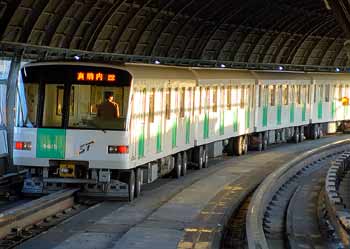
Image & license: Sameboat / Wikipedia encyclopædia. CC BY-SA 3.0 http://commons.wikimedia.org/wiki/File:ST_SN5000_20061102_001.jpg |
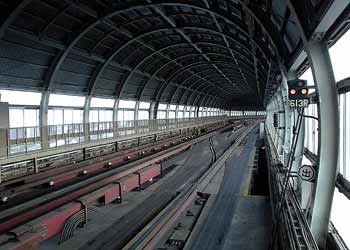
Image & license: Nobinobita / Japanese Wikipedia User CC BY-SA 3.0 http://commons.wikimedia.org/wiki/File:Sapporo_subway_shelter.jpg. |
||||
| These images were taken on the southern section of the line which is elevated and to protect it from heavy winter snowfall (as well as reduce noise) is enclosed in an aluminium shelter. | |||||
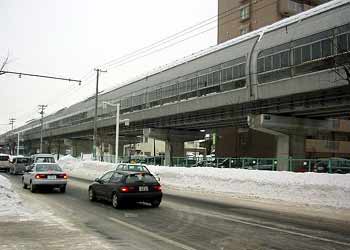
Image & license: Kinori / Wikipedia encyclopædia. Public Domain. http://commons.wikimedia.org/wiki/File:SapporoNanbokusen.jpg |
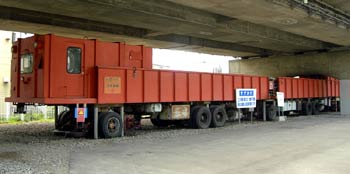
Image & license: Rsa / Wikipedia encyclopædia. CC BY-SA 3.0 http://commons.wikimedia.org/wiki/File:Sapporo_subway_test_car_suzukake.jpg |
||||
More images from Sapporo's Nanboku Line showing the shelter from the outside and a prototype vehicle - on which (at the front) it is possible to see the side rollers which grip the central guiding rail.
Other Japanese rubber tyred systems include the Kobe Port Island Line (also known as Port Liner) and New Transit Yurikamone. Both of these use side guidewalls for guidance and are automated driverless systems so are often known as 'automated guided transits' (AGT). |
|||||
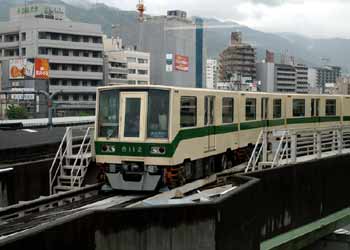 |
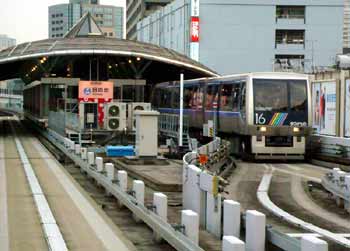 |
||||
| Port-Liner at Sannomiya station.
Image & license: Hideyuki KAMON / Wikipedia encyclopædia. CC BY-SA 2.0 commons.wikimedia.org/wiki/File:Port_Liner_at_Sannomiya_Station.jpg. |
Tokyo New Transit Yurikamome at Hinode station.
Image & license: Hideyuki KAMON / Wikipedia encyclopædia. CC BY-SA 2.0 commons.wikimedia.org/wiki/File:Hinode_Station_(Tokyo)_in_2008.jpg. |
||||

Direct links to other Passenger Train Variations pages.
 |
|||||||||||||||||||||||||||||||||||||||||||||||||||||
 |
|||||||||||||||||||||||||||||||||||||||||||||||||||||
 |
|||||||||||||||||||||||||||||||||||||||||||||||||||||
 |
|||||||||||||||||||||||||||||||||||||||||||||||||||||
 |
|||||||||||||||||||||||||||||||||||||||||||||||||||||
citytransportinfo is also here:
share this page with your friends!